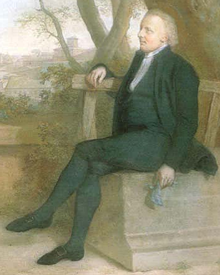Regency Personalities Series
In my attempts to provide us with the details of the Regency, today I continue with one of the many period notables.
Frederick Hervey 4th Earl of Bristrol
1 August 1730 – 8 July 1803

Frederick Hervey
Frederick Hervey was educated at Westminster School and Corpus Christi College, Cambridge, graduating M.A. in 1754.
In 1779, Hervey became Earl of Bristol (succeeding his brother Augustus Hervey) and also owner of the family’s ancestral estate at Ickworth in Suffolk. In 1795 he began building the present Ickworth House both as a family home and as a place to display his extensive art collection. Only the shell of the Rotunda was finished when he died in 1803 and wings were completed by his son. In 1799 he also inherited the Elizabethan-era title of Baron Howard de Walden from a distant cousin, when the abeyance of this peerage was terminated.
Entering the church Hervey became a royal chaplain; and while waiting for other preferment spent some time in Italy, whither he was led by his great interest in art. In February 1767, while his eldest brother, the 2nd Earl of Bristol, was Lord Lieutenant of Ireland, he was made Bishop of Cloyne, and having improved the property of the see he was translated to the rich Bishopric of Derry a year later. As Bishop of Derry, Hervey was known as “the most worldly, most eccentric, most talked-about priest in the Church of Ireland”.
As Bishop of Derry, he was active and philanthropic, although considered at times cheerfully sadistic towards those under him; in one famous example he had the portly priests who wished to be considered for a plum position compete in a midnight run through bogs and swamps. While not neglecting his luxurious personal tastes he spent large sums of money on making roads and assisting agriculture, and his munificence was shared by the city of Derry. He built splendid residences at Downhill and Ballyscullion, which he adorned with rare works of art.
Hervey favoured complete religious equality, and was opposed to the system of tithes. Having again passed some time in Italy, he returned to Ireland and in 1782 threw himself ardently into the Irish volunteer movement, quickly attaining a prominent position among the volunteers. In great state he attended the convention held in Dublin in November 1783.
Carried away by his position and popularity Hervey’s talk of rebellion and violent language led the government to contemplate his arrest. Subsequently he took no part in politics, spending his later years mainly on the continent of Europe. In 1798 he was imprisoned by the French at Milan as a suspected spy, remaining in custody for eighteen months. He died outdoors at Albano, denied refuge, and was buried in Ickworth Church.
Varying estimates have been found of his character. He was considered clever and cultured, but licentious and eccentric. He was a great collector of art and in later life he openly professed materialistic opinions. He fell in love with the countess Lichtenau, mistress of Frederick William II of Prussia and by his bearing and often unusual and ostentatious style of dress he gave fresh point to the saying that “When God created the human race, he made men, women and Herveys.”
During his European travels he was known to walk around Rome wearing a broad-brimmed white hat, many chains and red breeches, possibly an attempt to upstage his Catholic rivals.
As a bishop, Hervey was industrious and vigilant (although he suffered long absences from Ireland) although a self-declared agnostic. At one point George III referred to him as “that wicked prelate.”
It is said that the Bishop’s knowledge of classical Europe and love of travelling inspired the fashion for Hotel Bristol becoming a common name for quality lodgings throughout the Continent.
In 1752 Lord Bristol had married Elizabeth Davers (d. 1800), daughter of Sir Jermyn Davers, 4th Baronet, a great-granddaughter of Thomas Jermyn, 2nd Baron Jermyn as well as the sister and heir of Sir Charles Davers, 5th Baronet (c. 1730-1763). By this marriage, Lord Bristol had four sons and three daughters:
- Lady Mary Caroline Hervey (1753–1842); married John Creichton, 1st Viscount (later 1st Earl) Erne.
- George (1755–1765); died of illness at the age of 9, in Spa, Belgium while the family was travelling.
- John “Jack” Augustus Hervey, Lord Hervey (1757–1796); predeceased his father.
- Lady Elizabeth Christiana Hervey (1758–1824); best known as the longtime mistress, and later second wife, of William Cavendish, 5th Duke of Devonshire.
- Short-lived son (b. and d. 1761)
- Lady Louisa Hervey (1767–1821); married Robert Banks Jenkinson, Lord Hawkesbury and 2nd Earl of Liverpool.
- Frederick Hervey, 1st Marquess of Bristol (1769–1859); had after his elder brother’s death the courtesy title of Lord Hervey.
When Bishop Lord Bristol died in 1803, his son Frederick succeeded as 5th Earl of Bristol and owner of the estates including Ickworth House. The title of Baron Howard de Walden however passed to his great-grandson Charles Ellis, son of the 1st Baron Seaford, who was the son of the only daughter of his son John.





























